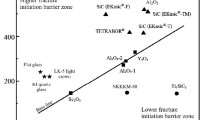The paper presents the experimental results of investigations using different types of glass by the Rockwell indenter scratching of the specimen surface till its edge chipping (S+EF method). The peculiar features of the materials’ fracture are determined as a result of fractography analysis of the empirical data. It is proposed to classify chips under two different groups. The first group is characterized by the edge fracture that is accompanied by the fully developed shell-like chip with typical zones of the fracture crack propagation (traces of axisymmetric quasi-cone crack propagation). The second group of chips involves the edge fracture without smoothly outlined borders of the fracture crack propagation on the lateral surface of the specimen with a set of branched and randomly oriented cracks having the reflecting zone of comparatively small dimensions. The mechanisms of variation in the shape of chip scars (fracture crack propagation trajectory) are implied with the increase of the fracture load on the indenter or fracture distance. It is established that the fracture resistance is invariant to the fracture load and does not depend on the asymmetry of chip scars according to their side views. The authors demonstrate the correlation dependence between the test results (the S+EF and SEVNB methods) on the different glass types, which reveals the effect on the specified cracking and chipping of the material in the zone of its contact with indenter for fracture resistance of glass under local edge loading. The authors propose to use the methods of indenter scratching of the specimen surface till its edge chipping as the rapid assessment of damage and fracture resistance of glass in the solution to the optimization tasks, certification procedure or materials’ selection.



Similar content being viewed by others
References
S. M. Wiederhorn, Strength of Glass – A Fracture Mechanics Approach, National Bureau of Standards, Washington (1974).
J. F. Knott, Fundamentals of Fracture Mechanics, Butterworths, London (1973).
H. Okuda and S. Ito, “Mechanical properties of ceramics. 6. Reliability and evaluation of ceramics,” J. Soc. Mater. Sci., 32, No. 358, 823–829 (1983).
K. K. Ray and A. K. Dutta, “Comparative study on indentation fracture toughness evaluations of soda–lime–silica glass,” Brit. Ceram. T.,98, No. 4, 165–171 (1999).
A. P. Kren’, “Determination of the critical stress intensity factor of glass under conditions of elastic contact by the dynamic indentation method,” Strength Mater., 41, No. 6, 628–636 (2009).
G. Geandier, S. Denis, and A. Mocellin, “Float glass fracture toughness determination by Hertzian contact: experiments and analysis,” J. Non-Cryst. Solids, 318, No. 3, 284–295 (2003).
K. Li, Y. Shapiro, and J. C. M. Li, “Scratch test of soda-lime glass,” Acta Mater., 46, No. 15, 5569–5578 (1998).
F. Petit, V. Vandeneede, and F. Cambier, “Ceramic toughness assessment through edge chipping measurements – Influence of interfacial friction,” J. Eur. Ceram. Soc., 29, No. 11, 2135–2141 (2009).
G. A. Gogotsi, V. I. Galenko, S. P. Mudrik, et al., “Glass fracture in edge flaking,” Strength Mater., 39, No. 6, 639–645 (2007).
V. V. Khvorostyanyi, “Mechanical behavior of ceramics and glass during specimen edge fracture caused by Rockwell indentor,” Strength Mater., 46, No. 3, 383–390 (2014).
J. A. Williams, “Analytical models of scratch hardness,” Tribol. Int., 29, No. 8, 675–694 (1996).
CEN/TS 843-9:2010. Advanced Technical Ceramics – Mechanical Properties of Monolithic Ceramics at Room Temperature, Part 9: Method of Test for Edge-Chip Resistance, CEN, Current from 2010-08-15.
A. Arora, D. B. Marshall, B. R. Lawn, and M. V. Swain, “Indentation deformation/ fracture of normal and anomalous glasses,” J. Non-Cryst. Solids, 31, No. 3, 415–428 (1979).
T. M. Gross and J. J. Price, “Vickers indentation cracking of ion-exchanged glasses: quasi-static vs. dynamic contact,” Front. Mater., 4:4 (2017), https://doi.org/10.3389/fmats.2017.00004.
S. S. Solntsev and E. M. Morozov, Glass Fracture [in Russian], Mashinostroenie, Moscow (1978).
A. Mohajerani and J. K. Spelt, “Edge chipping of borosilicate glass by blunt indentation,” Mech. Mater., 42, No. 12, 1064–1080 (2010).
A. George and G. D. Quinn, “Edge chip testing of ceramics,” Am. Ceram. Soc. Bull., 92, No. 1, 24–28 (2013).
N. J. McCormick and E. A. Almond, “Edge flaking of brittle materials,” J. Hard Mater., 1, 25–51 (1990).
J. Quinn and I. Lloyd, “Flake and scratch size ratios in ceramics,” in: J. R. Varner and G. D. Quinn (Eds.), Fractography of Glasses and Ceramics IV, Ceramic Transactions (Vol. 122), American Ceramic Society, Westerville, OH (2001), pp. 55–72.
G. A. Gogotsi, “Edge chipping resistance of ceramics: Problems of test method,” J. Adv. Ceram., 2, 370–377 (2013).
BS EN ISO 23146:2016. Fine Ceramics (Advanced Ceramics, Advanced Technical Ceramics). Test Methods for Fracture Toughness of Monolithic Ceramics. Single-Edge V-Notch Beam (SEVNB) Method, BSI Group, Current from 2016-05-31.
Author information
Authors and Affiliations
Corresponding author
Additional information
Translated from Problemy Prochnosti, No. 1, pp. 73 – 83, March – April, 2020.
Rights and permissions
About this article
Cite this article
Khvorostyanyi, V.V., Gogotsi, G.A. Specific Features of Glass Damage and Fracture Resistance under the Rockwell Indenter Scratching of the Specimen Surface until the Edge Chipping Appearance. Strength Mater 52, 243–251 (2020). https://doi.org/10.1007/s11223-020-00171-0
Received:
Published:
Issue Date:
DOI: https://doi.org/10.1007/s11223-020-00171-0




